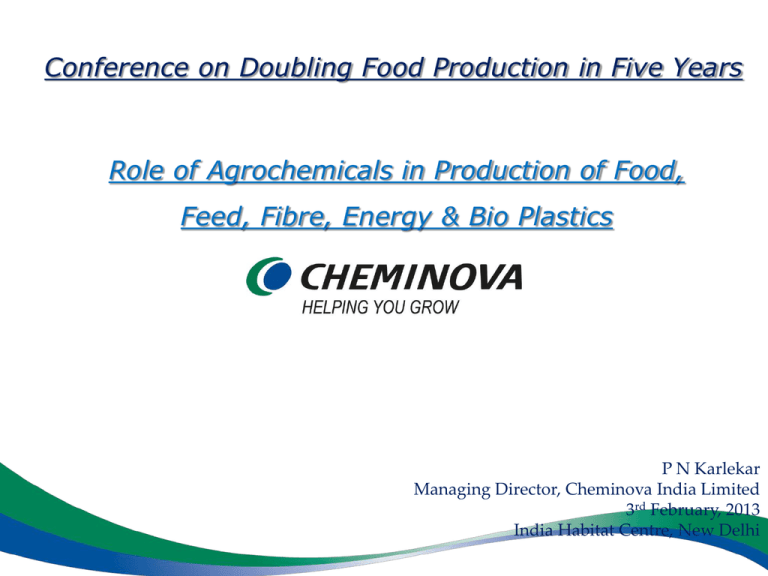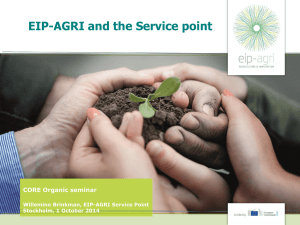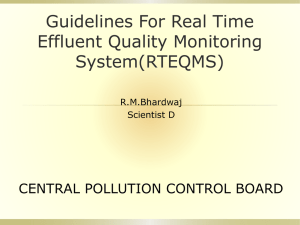P N Karlekar - Cheminova
advertisement

Conference on Doubling Food Production in Five Years Role of Agrochemicals in Production of Food, Feed, Fibre, Energy & Bio Plastics P N Karlekar Managing Director, Cheminova India Limited 3rd February, 2013 India Habitat Centre, New Delhi Contents Food Scenario Economic Indicators Relevance of Agriculture Importance of Agrochemicals Role of Industry Thought to Ponder Over Food Scenario Food Scenario 1964-65 : very good monsoon but still food aid was 7 Mio Tons out of 68 Mio Tons. 1965-66 : in drought food production reduced by 17 Mio Tons and therefore foreign experts opined that India could never be self-sufficient in food. 2012 monsoon comparable to 1965 - 66 Green revolution raised total food availability due to increased yields Food Scenario Starvation reduced because of reasons largely other than Agriculture : Better distribution/roads Better employment and consequent affordability. Irrigation from 30% to 55% through bore wells (4/5th of total) Good Rabi due to bore wells. Agriculture as % GDP reduction from 52% to 14%. Now India can afford import food. Food stocks are 80 Mio Tons. Drought may no longer mean starvation but inflation Rising Population with Growing Income driving the Food demand I n d i a n P o p u l a t i o n i n M n . P e r C a p i t a I n c o m e i n R s . By 2020, India’s Population to be 1.32 billion & needs 300 Mio Mt. of Food grains to meet the demand Source :- CSO Present Food Production not enough to meet the growing demand Fluctuating and stagnant Production of Food grains in fact declined the availability from 510 g in 1991 to 460 g in 2011 Source :- Dept. of Agriculture & Cooperation Nutritional Status of Indian Population is far from satisfactory India ranks 67th in a list of 81 countries on the World Hunger Index In India 828 Million People under mal nutrition and 551 million people in Sub – Saharan Africa Unfortunately, half of the World’s hungry people are in India 21 % of our Population is undernourished, 50 % of Children are malnourished & 75% of Women suffer from anemia Economic Indicators Economic Indicators GDP Growth in 2012 est. to be 5.5 % against Budget Estimate of 7.6 % Indian GDP : US $ 1.7 trillion (INR 75 Lac Cr.) Total Liabilities : INR 51 Lac Cr. (Sovereign Debt, Pensions, Savings Liability) Tax Revenue : INR 7.7 Lac Cr. Expenses : INR 13.2 Lac Cr. Fiscal deficit : INR 5.2 Lac Cr. Fixed Expenses : Interest - INR 2.8 Lac Cr. Defence – INR 1.8 Lac Cr. Subsidies – INR 2.2 Lac Cr. Proposed Food Security Bill – INR 1.5 Lac Cr Economic Indicators Current A/C deficit – 4.2 % Fiscal deficit – 5.7 % Revenue Deficit – 3.4 % India’s debt to GDP ratio - 80% Av. WPI Inflation – 7.5 % Declining Capital Expenditure to total Expenditure 1991 - 25 % 2013 - 14 % Economic Indicators Central bank has enhanced the investment limit in debt instruments for FII’S from $10 bn to $75 bn, perhaps to help finance current account deficit (4.2% against maximum desired 3% ) Our External debt has worsened by $20 bn in September compared to March. Foreign Exchange reserves / External debt is now 80% from earlier 85% The debt to be repaid in near term accounted for 43% of total External debt & 52% of Foreign Exchange Reserves India Probably needs to grow at 6% or more to maintain financial Stability. Lower growth than that, would make the public debt harder to bear & scare off Foreign Capital that India needs to fund its current account deficit & pay for its imported energy Economic Indicators India’s dependence on Foreign Oil is growing & Fuel Import is 38 % of total Merchandize Imports Less than 1/3 rd of the Population uses LPG for Cooking 300 Million don’t have access to Electricity 40% Power Lost in Transmission 54,000 MW Power against the target of 78700 MW during the 11th Plan at only 69 % of the target Only 46.9 % of the total 246.6 million households have toilet facilities and in stark contrast, 63.2 % of the households own a telephone, 53.2 % mobile phones, 47.2 % own Television. Reforms are needed in Electricity, Labour, Land & Capital Relevance of Agriculture Relevance of Agriculture Contribu tors to the Growth Relevance of Agriculture IT employs only 2.0 Mio out of 1.2 Billion. Services alone can not possibly feed millions Relevance of Agriculture In two decades from now, there will be 2 billion more people wanting & deserving to boost themselves out of poverty Growth in Agriculture Sector is 4 times more effective in reducing Poverty than other Sectors UN projection is that India will cross China’s population by 2030 & will reach 1.6 billion by 2050 People packed in Slums need help but the problems that need’s solving is poverty not over population. 80 % of Public Expenditure in Agriculture in Input Subsidies (Fertilizers, Power & Irrigation) & remaining 20 % only as Investment in Agriculture Rising Food Prices hurting the common man “Aam Admi” There is not a quick fix of the price issue :- Bold Reforms required Investment in Agriculture by Govt. is not that easy given the fiscal deficit of est. 5.7 % in 2012 - 13 % Share of Food in Total Consumption Expenditure Indian spend ~ 50 % of their total monthly expenditure on Food Rural India Spend ~ 30 % of their food expenditure on Rice & Wheat & Urban India ~ 22 %. Decreasing arable land - challenges of producing more from less India with 11 % of arable land to feed 17 % of the World Population Arable Land :– 166 Mio Ha to 158 Mio Ha Land for non agricultural uses :- 7 % in 1991 to 10 % in 2010 One Viable Improving Option - Agricultural Productivity to satisfy the growing demand for food, fibre, fuel & bioplastics Diminishing Average Land Holding (Ha.) Importance of Agrochemicals Relevance of Agrochemicals In India, Only 25 – 30 % farmers are aware of the use of Pesticides with ~ 35 – 40 % of the farm lands under crop protection There is an urgent need to educate the farmers on the benefits of using agrochemicals to raise farm productivity Cost : Benefit Ratio of Agrochemical Usage On an average, India import ~ 3 Mio Mt. of Pulses every year at a cost of Crores INR & 10,000 research proved that Control of Pod borer - a common pest can reduce the Increasing yields, in my view, is the only feasible solution to address the problem of stagnant arable land feeding the rising population and ensuring “Food Security” India’s reliance Pulses import on Agro Chemicals for Sustainable Agriculture & Human Health Usage of herbicides with less tillage (Zero Tillage) enable farmers to grow more per unit area and prevent soil erosion Weed control can enhance 2 – 3 Million Mt. of Pulse Production :- Dr. K. Kasturirangan (Member Planning Commission) 100 % Seed treatment – Efficient way of controlling losses & getting better quality yield Weedy rice :- difficult to control by manual weeding as it looks same in the beginning & can reduce the rice yield by 40 %. :- Dr. Jay G Varshney – Director – DWSR (Directorate of Weed Science Research) Health & Hygiene :- Mosquito Control, Malaria Parasites Key Differentiator Technology – Lowest Common Denominator Wide spread Adoption of Herbicides use in rice & wheat in Punjab & Haryana in a way contributed to higher productivity Gap between on Yields with Improved Agronomic Practices and adoption of modern technologies in Punjab & Haryana compares well with the developed nation Organic Agriculture Green Movement presupposes that Life of Future generation in developed world is more important than present lives of Developing / under Developed World Organic Agriculture Some findings on Organic Agriculture India’s total Organic Food Production – 1.8 Mio Mt Yield is 35 – 62 % lower than the conventional Organic requires 35 % more labour Affordability of Organic Foods ???? Long Term Sustainability ??? Myths about Pesticides Toxicity Organic foods are not safer than Conventional Role of Agrochemicals Enhanced Productivity matching the Per acre yield with the best of the world More Grains per unit of Land More Grains per unit of Labour More Grains per unit of Water More Grains per unit of Energy Agrochemicals fulfilling the global cause of feeding billions, many of whom are still suffering starvation, while conserving the scarce resources such as Land, Water & Energy Role of Industry Enlightening the Bureaucrat, Judiciary, Media, Political master & Society at large on the positive contribution & crucial importance of Agrochemicals & busting the myth about toxicity Making Investment of time & training resources for educating farmers about best Agricultural Practices Making Investment in Agriculture by participating in Micro Projects through PPP Cheminova’s Humble Contribution Cheminova’s one of the belief that “Education” is crucial for building a Just, equitable, humane & sustainable Society Education is a good equalizer specifically disadvantaged sections of the Society for underprivileged Cheminova India Limited in coordination with State Agricultural Universities, Agricultural Deptt. & Non – Governmental Organization have selected few villages which are not easily accessible across agro climatic regions of India for making little difference in their way of life by working together with the rural populace. & Cheminova’s Mission “We help improve quality of life for the world’s population by supplying products that help farmers increase yields and quality of crops to satisfy the global demand for food, feed, fiber and energy.” We Contribute to make a Better World – We make a difference! Thought to Ponder Over Thought to Ponder Over Entire Developed World gives lip service in Organic Farming, whereas Technology incl. uses best scientific of use the Agricultural of appropriate quantities of Agrochemical to achieve Superior Yields & Quality Real need of higher yield is more for India which has maximum population of BPL families The real need for India is to reduce Poverty & not Population Thank You










